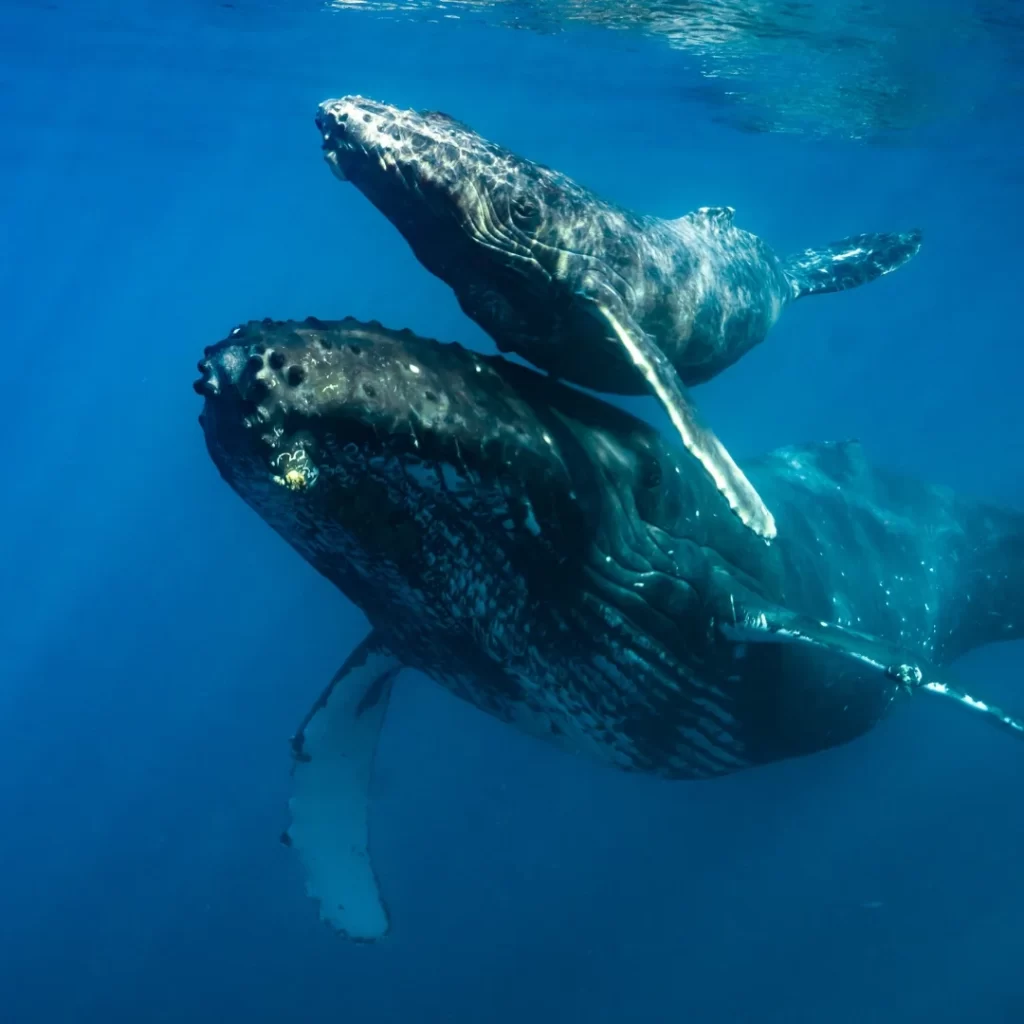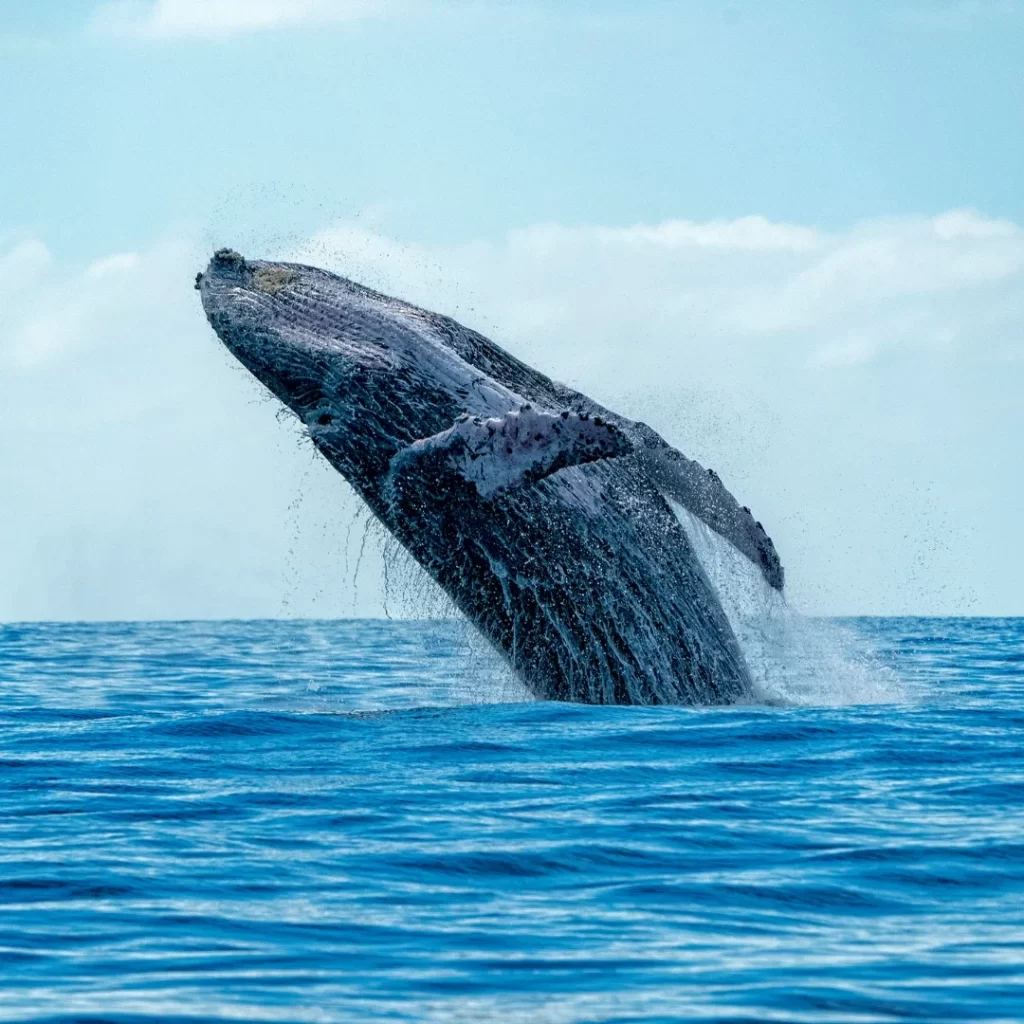Whale Watching
Enjoy Cabo's whale watching to the fullest
Whale Watching in Los Cabos
A Must-Do Experience
Thousands of whales migrate to the warm waters of Mexico each winter, making Los Cabos one of the best places to see the amazing humpback whales in action. Known for their impressive leaps and splashes, these majestic creatures offer unforgettable moments you can enjoy from the shore or up close on a boat tour. Recognized as one of Mexico’s top whale-watching destinations, Los Cabos offers countless opportunities to witness humpback whales displaying their natural behaviors. This guide provides all the essential information, including the best times to go and money-saving tips, to ensure you have an unforgettable and responsible experience.
Fascinating Facts About Humpback Whales
Humpback whales are easily distinguishable by their dark grey or black bodies adorned with white patches on their bellies and the distinctive knobs, known as tubercles, on their heads. Their large pectoral fins, which contribute to their Latin name, Megaptera novaeangliae (meaning “big wing of New England”), make them remarkable. Humpback whales in oceans worldwide are well-known for their mesmerizing songs—beautiful mixes of moans, howls, and cries that can be heard over great distances underwater. While they may not be the biggest whales, with lengths ranging from 45 to 68 feet, humpbacks are adored for their lively behavior and captivating presence. Humpbacks have two blowholes positioned on top of their heads, and they get their name from the hump shape their back forms as they dive beneath the surface. While commercial whaling once threatened their populations, dedicated conservation efforts have helped these magnificent creatures achieve a “Least Concern” status today.
Best Spots to See Humpback Whales in Los Cabos, Mexico
Cabos is undoubtedly one of the world’s premier destinations for whale watching. Each winter, humpback whales, along with several other species, migrate from the cold arctic waters of Canada to Mexico’s Pacific coast, where they spend the season in warm, sheltered waters. Here, they mate and give birth before returning to their northern feeding grounds during summer. Baja California Sur (BCS), the region surrounding Los Cabos, is the top area in Mexico for whale watching. While grey whales can be spotted in coastal calving lagoons and the elusive blue whale occasionally appears off the coast of the Sea of Cortez, humpback whales are most commonly sighted in these waters.
One of the unique features of Los Cabos is that whales can often be seen right from the shore. Whether you’re staying at a coastal resort, enjoying a meal at a beachside restaurant, or taking a stroll along Lovers Beach, there’s a good chance you’ll catch a glimpse of these magnificent creatures. A whale-watching tour is a must for those looking for a closer encounter. Los Cabos offers a variety of tour operators, and surprisingly, not everyone takes advantage of the incredible whale-watching opportunities, which means there’s plenty of space for those who do.
To truly appreciate these majestic animals, choosing a licensed whale-watching tour is important. Not only does this ensure an up-close experience, but it also supports ethical practices that protect the whales and help their populations thrive. Experienced guides on these tours enhance your experience, making it both enjoyable and educational while contributing to the conservation efforts that keep these amazing creatures safe.
Whether you’re witnessing them from the shore or up close on a tour, Los Cabos is the ultimate spot for whale watching in Mexico.
Best Time for Whale Watching in Los Cabos
the presence of whales can never be guaranteed, certain times of day and year can significantly increase your chances of an unforgettable encounter in Los Cabos. Humpback whales migrate to the area between mid-December and mid-April, with the peak season from January to March. During these months, your chances of spotting whales are incredibly high—over 95%. February is particularly exciting as whale calves begin to explore and learn from their mothers, offering plenty of opportunities to witness playful behaviors and intense heat runs.
Regarding the best time of day, mornings are often ideal for whale watching. The seas are usually calmer, making the trip more comfortable, especially if you’re prone to seasickness. Additionally, the bay in Los Cabos tends to be quieter in the morning before the party boats hit the water later in the day. A morning tour can provide a more peaceful and rewarding experience, with fewer boats around, making it easier to spot and enjoy the whales. While some believe humpbacks prefer choppier waters for more active displays, spectacular sightings can occur at any time of day, so no matter where you go, you’re in for a treat.
Other Whale Watching Destinations in Baja California Sur
you’re as captivated by whales as we are, consider extending your whale-watching adventure to other parts of Baja California Sur. Magdalena Bay is home to a protected grey whale sanctuary, where you can stay in a dedicated whale-watching camp. Further along the coast, the tranquil town of Loreto is one of the best places in the world to see blue whales—the largest animals on Earth. Los Cabos and Baja California Sur offer whale-watching experiences and many incredible opportunities to witness these majestic creatures. Choose a responsible tour operator, and you’ll create memories that will last a lifetime.
Whale Behaviors to Look Out For
While every whale-watching trip offers a unique experience, there are several behaviors you might witness on your tour:
- Blowing: The telltale sign of a nearby whale is a cloud of mist, known as a blow, caused by the whale expelling air during breathing.
- Breaching: One of the most thrilling sights is a humpback whale launching out of the water. This spectacular display could be a form of communication, a territorial signal, or even a way to alert others to nearby predators or food.
- Spyhopping: When a whale pokes its head out of the water to observe its surroundings, it is known as spy hopping.
- Slapping: Humpbacks may slap their tails, fins, or heads against the water’s surface, creating a loud splash. These behaviors can serve various purposes, including communication and play.
- Fluking: As the whale dives, it may lift its tail out of the water, a behavior known as fluking.
As humpbacks come to Cabo to give birth, you may also see baby whales learning these behaviors from their mothers. If you’re fortunate, you might even witness a “heat run,” where males compete for a female’s attention in a spectacular display of speed and agility.
Whale Watching Regulations and Responsible Practices in Los Cabos
Whale watching in Mexico is carefully regulated to protect both the whales and their species and ensure the safety of everyone on board. In Los Cabos, these regulations are enforced by SEMARNAT (Mexico’s environment ministry), which sets strict guidelines for licensed operators. These rules include speed limits, minimum distances, and time restrictions, all essential for a safe and respectful interaction with these magnificent animals. A large “No Approach Zone” is also enforced around the whales, allowing them the space to move freely and engage in their natural behaviors without disturbance. Only vessels with the proper permits are authorized to conduct whale-watching activities, and they must carry a distinctive flag to indicate their compliance.
However, there have been instances in Baja California Sur where unlicensed boats have gotten too close to whales, leading to dangerous situations for the whales and the passengers. For this reason, it is important to choose a licensed and reputable tour operator. Licensed operators adhere to the regulations designed to protect these incredible animals and ensure that your whale-watching experience is safe and educational. By supporting responsible tour operators, you directly contribute to the conservation of humpback whales in Los Cabos, helping protect them for future generations.
Choosing a reputable tour operator enhances your experience and supports the ethical practices to keep these amazing creatures safe. Whether witnessing whales from the shore or on a boat, practicing responsible whale watching is key to ensuring these majestic animals’ continued survival and well-being.
In need of suggestions?
Are you planning that perfect trip down to beautiful Baja? We are only a message away from helping you with the vacation planning.



